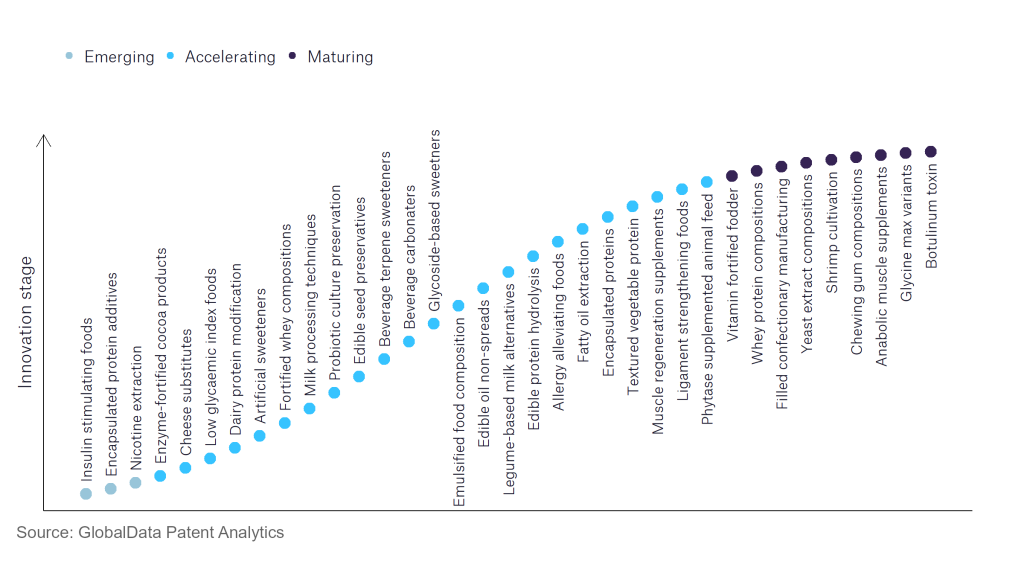The consumer industry continues to be a hotbed of innovation, with activity driven by convenience, aesthetics and environmental sustainability, and growing importance of technologies such as 3D food printer, alternative proteins, and digital food management. In the last three years alone, there have been over 450,000 patents filed and granted in the consumer industry, according to GlobalData’s report on Innovation in Consumer: Ligament strengthening foods. Buy the report here.
However, not all innovations are equal and nor do they follow a constant upward trend. Instead, their evolution takes the form of an S-shaped curve that reflects their typical lifecycle from early emergence to accelerating adoption, before finally stabilising and reaching maturity.
Identifying where a particular innovation is on this journey, especially those that are in the emerging and accelerating stages, is essential for understanding their current level of adoption and the likely future trajectory and impact they will have.
40+ innovations will shape the consumer industry
According to GlobalData’s Technology Foresights, which plots the S-curve for the consumer industry using innovation intensity models built on over 110,000 patents, there are 40+ innovation areas that will shape the future of the industry.
Within the emerging innovation stage, hydrogel dressings, dextrin-based compositions, and safety injection needles are disruptive technologies that are in the early stages of application and should be tracked closely. Muscle regeneration supplements, allergy alleviating foods, edible oil non-spreads are some of the accelerating innovation areas, where adoption has been steadily increasing. Among maturing innovation areas are whey protein composition and anabolic muscle supplements, which are now well established in the industry.
Innovation S-curve for the consumer industry

Ligament strengthening foods is a key innovation area in consumer
Health-conscious consumers are increasingly seeking fermented dairy products such as yogurt and buttermilk, and foods like sardines, salmon, spinach, cabbage family foods, and peas for ligament and tendon strength since they consist of a lot of calcium.
GlobalData’s analysis also uncovers the companies at the forefront of each innovation area and assesses the potential reach and impact of their patenting activity across different applications and geographies. According to GlobalData, there are 20+ companies, spanning technology vendors, established consumer companies, and up-and-coming start-ups engaged in the development and application of ligament strengthening foods.
Key players in ligament strengthening foods – a disruptive innovation in the consumer industry
‘Application diversity’ measures the number of different applications identified for each relevant patent and broadly splits companies into either ‘niche’ or ‘diversified’ innovators.
‘Geographic reach’ refers to the number of different countries each relevant patent is registered in and reflects the breadth of geographic application intended, ranging from ‘global’ to ‘local’.
Patent volumes related to ligament strengthening foods
| Company | Total patents (2021 - 2023) | Premium intelligence on the world's largest companies |
| Nestle | 42 | Unlock Company Profile |
| Axcella Health | 21 | Unlock Company Profile |
| Sinphar Pharmaceutical | 18 | Unlock Company Profile |
| Newtree | 18 | Unlock Company Profile |
| Abbott Laboratories | 16 | Unlock Company Profile |
| Oncocross | 15 | Unlock Company Profile |
| Brainon | 13 | Unlock Company Profile |
| Otsuka Holdings | 11 | Unlock Company Profile |
| Probiotical | 11 | Unlock Company Profile |
| Royal DSM | 11 | Unlock Company Profile |
| L’Institut National Recherche Agronomique | 10 | Unlock Company Profile |
| Amazentis | 9 | Unlock Company Profile |
| Chong Kun Dang Healthcare | 9 | Unlock Company Profile |
| Omni Active Health Technologies Pvt | 9 | Unlock Company Profile |
| Ajinomoto | 9 | Unlock Company Profile |
| Tanzania Commission for Science and Technology | 8 | Unlock Company Profile |
| Raytheon Technologies | 8 | Unlock Company Profile |
| Smartfish | 8 | Unlock Company Profile |
| North Health Essentials | 8 | Unlock Company Profile |
| Gelita | 7 | Unlock Company Profile |
| Green Cross Holdings | 6 | Unlock Company Profile |
| Tereos | 6 | Unlock Company Profile |
| Cosmax | 5 | Unlock Company Profile |
Source: GlobalData Patent Analytics
Nestle is one of the leading patent filers in ligament strengthening food. Some other key patent filers in ligament strengthening food include Axcella Health, Sinphar Pharmaceutical, Newtree, and Abbott Laboratories. Recently, Nestle announced that it is exploring emerging technologies for animal-free dairy protein-based products. Further, Nestle will pilot a novel product through its newly established U.S. R+D Accelerator. To be made through animal-free protein, the lactose-free product offers good nutritional and functionality benefits and is suitable for vegans.
In terms of application diversity, Newtree leads the pack. Cosmax and Ajinomoto stood in the second and third positions, respectively. By means of geographic reach, Oncocross held the top position, followed by Otsuka and Royal DSM.
Ligament strengthening products will increasingly gain popularity as health-conscious and physically active consumers look for products with nutritional features. Hence, leading food companies must continue to innovate through emerging technologies to launch dairy products as per the needs of the customers.
To further understand the key themes and technologies disrupting the consumer industry, access GlobalData’s latest thematic research report on Consumer.
Data Insights
From

The gold standard of business intelligence.
Blending expert knowledge with cutting-edge technology, GlobalData’s unrivalled proprietary data will enable you to decode what’s happening in your market. You can make better informed decisions and gain a future-proof advantage over your competitors.



